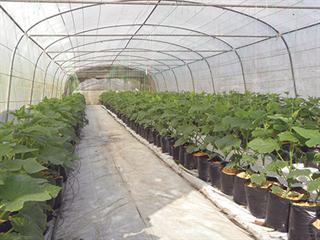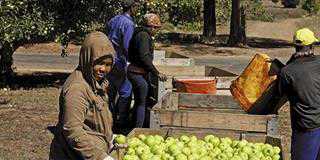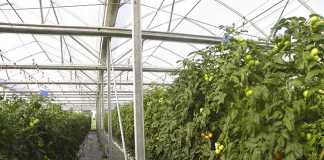
Irrigation for intensive horticultural systems is in effect fertigation, since the fertilisers used on the protected crops
are applied in the water, says Paddy de Vries, national technical advisor for local seed and agro-chemical company Hygrotech. Although a wide variety of irrigation products is available these days, there are in fact just two basic systems: drain-to-waste and recirculating. Farmers must choose which one suits them.
Drain-to-waste-irrigation
Drain-to-waste is more common in South Africa as it is cheaper and easier to use. This system has the advantage that the crop is continually fed the correct quantity of nutrients. Those that are not taken up by the plant drain away so they cannot build up as they would do in a closed system in which water is recirculated. Run-off water need not go to waste – it can be used elsewhere in the operation. “The drain-away water can be used to fertilise pastures or lands that are not under cover,” Paddy suggests.
Recirculating irrigation
In a recirculating system, it is difficult to know exactly what the plants have removed from the fertiliser water and therefore what remains, says Paddy. “Without runoff, we’re second-guessing the plant,” he explains. Because fertiliser is added at a fixed rate in a recirculating system, a build-up of nutrients will occur. There may also be a problem with disease in a recirculating system, in the same way as aircraft passengers often pick up infections on flights with recirculating air pushing bacteria or viruses through a closed system.
Recirculating systems are also not suited to saline water. Yet another problem with recirculation is that water running slowly past plant roots does not provide oxygen. Although there are recirculating irrigation systems that allow water to run through cells to create air spaces, making oxygen available in the process, plants may grow root mats and block these air cells.
Finally, recirculating irrigation products are generally expensive. Despite these drawbacks, there are an important advantage to recirculation: water and nutrients are recycled, which could make all the difference in a water-scarce area.
Good management
Tunnels are irrigated by means of dripper systems. It is crucial that greenhouse drippers be pressure-compensated to ensure an even supply, explains Paddy. Growers who plant flat-growing crops such as lettuce, swiss chard and strawberries use water through overhead spitters to cool down the leaves and to create humidity, but these are additional to the dripper irrigation.
Maintenance is a key factor in intensive horticultural enterprises. Hard-working pumps must be routinely checked and serviced, as pump failure can spell potential disaster for the grower. Pipeline blockages must be attended to immediately, so that plants are not deprived of essential water and nutrients. Planning is essential, and it is better
to have an overcapacity with water filtration systems, pipe capacity, pump capacity and number of valves but not with fertiliser, which can be added but is very difficult to remove, says Paddy.
Fertilising the protected crop
“In open field agriculture, organic or inorganic fertiliser is normally supplied to the soil in a dry form, and irrigation or rain dissolves it and hopefully takes the nutrients to the root in the correct amounts,” Paddy explains. “In fertigation, the calculated nutrients are dissolved in the irrigation water that transports them to the roots.”
The fertiliser is added to the irrigation line from two or more concentrate tanks that contain different nutrients, and there is also a pH control tank. The systems must be flexible enough to adapt, so that fertiliser requirements can match plant needs, which will change seasonally and with plant growth. Electrical conductivity in irrigation water is an indication of the salts present: if the conductivity is high, salt water must be added; if it is low, fertiliser must be added.
“To get the prescribed electrical conductivity and pH levels, it is best to control pumping by computer and mix concentrates into water. But simpler systems such as Dosatron (operating on the Venturi principle) can be used.
“Poor management or a weak system produces a cascade of negative effects. Over-irrigation or over-fertilisation is a major problem – we call this ‘killing the plant with kindness’,” says Paddy.
Too much water displaces oxygen and creates an environment suitable for pathogen attack. Uneven distribution of water in the root profile can also lead to salinity problems or conditions that are too dry.
Water quality
Water used to irrigate tunnel crops must be clean, and the mineral and chemical content should be analysed, so that the grower can take this into account. For a tunnel farmer, primary water problems are turbidity and microbiological loads.
Turbid water contains organic material, mud and soil that can be removed by filtration or flocculation. Sand filters are commonly used, and water can be flocculated by centrifuge pumps. Microbiologically contaminated water containing human and plant bacteria, fungi and viruses must be disinfected using approved methods and disinfectants such as ultraviolet light, ozone and hydrogen peroxide, explains Paddy.
“Oxygen should be added cautiously to the water because it can oxidise certain elements, such as iron and sulphur, and you don’t want that happening. However, oxygen generally improves the growth and health of the plant, and a healthy plant has better disease resistance,” he says.
Disinfection control is governed by Act 29 of the Agricultural Disinfection Act. To control disease-causing microbes, Paddy advocates the use of Sporekill, a fungicide, bacteriocide and viricide that must be applied at a concentration of 20ppm or 20ml per 1 000l of water.
Climate and environment
The irrigation regime needs to be matched to the attributes of the growing medium, with soil becoming more popular because it is cheap. “In humid conditions, the wetting period must not be too long, as certain diseases thrive in wet, humid conditions, but in very dry areas, the grower may have to ‘provide climate’ as it were, so the greenhouse manager should take the regional climate into account when he or she plans the irrigation,” Paddy says.
Daily and seasonal demands differ, as do the requirements from different crops. Richard Thurbon, an Australian hydroponic tomato grower, says that it is difficult to quantify plants’ water demand, but understanding how a plant grows and controlling the environment effectively saves water by reducing transpiration and plant water demand.
Phone Paddy de Vries on 082 633 1222.













